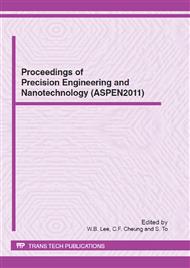p.1
p.7
p.13
p.19
p.25
p.30
p.36
p.42
Tool Deflection Modeling in Ball-End Milling of Sculptured Surface
Abstract:
The error due to tool deflection is detrimental to machining precision. In order to predict tool deflection more accurately, this paper presents a special three segments cantilever beam model for ball-end tool deflection in sculptured surface milling. Different from the traditional two segments cantilever beam method, the ball-end tool is divided into the shank, the flute and the ball-end parts in this new model. Then the ball-end tool deflection is simulated also by utilizing the finite element software ANSYS 12.0 Workbench to calibrate the accuracy of the tool deflection models. The three segments cantilever beam model for ball-end tool deflection matches better the finite element method (FEM). In the last part of the paper, the sculptured surface machining experimental results show that, the surface precision after tool deflection compensation based on the new three segments cantilever beam model is higer than that based on the two segments cantilever beam model.
Info:
Periodical:
Pages:
7-12
Citation:
Online since:
June 2012
Authors:
Price:
Сopyright:
© 2012 Trans Tech Publications Ltd. All Rights Reserved
Share:
Citation:


